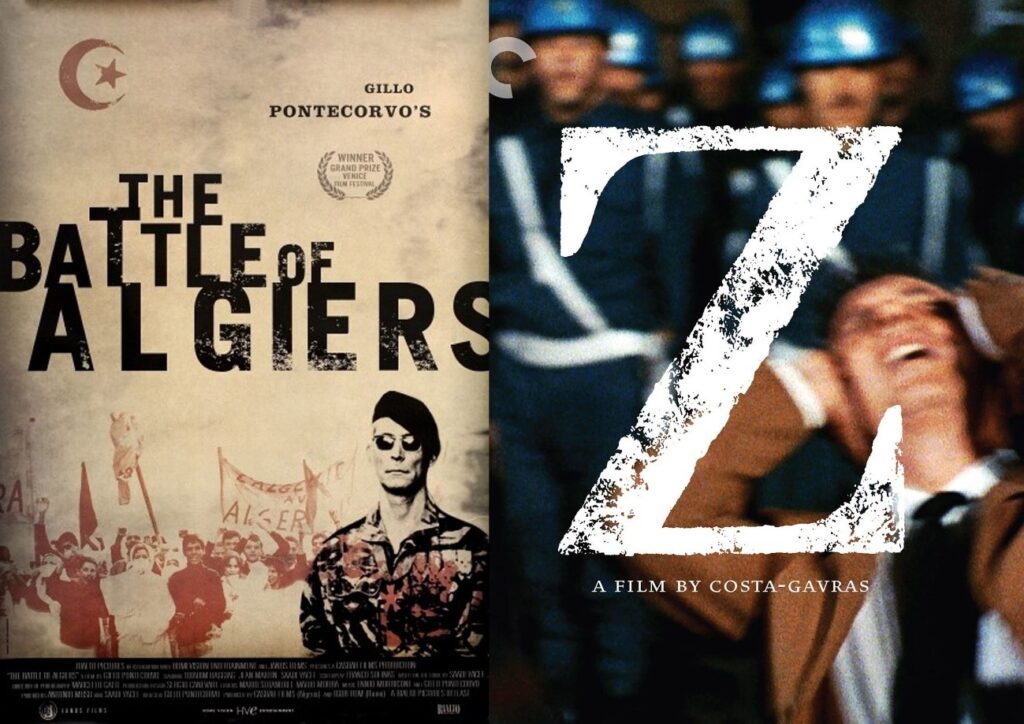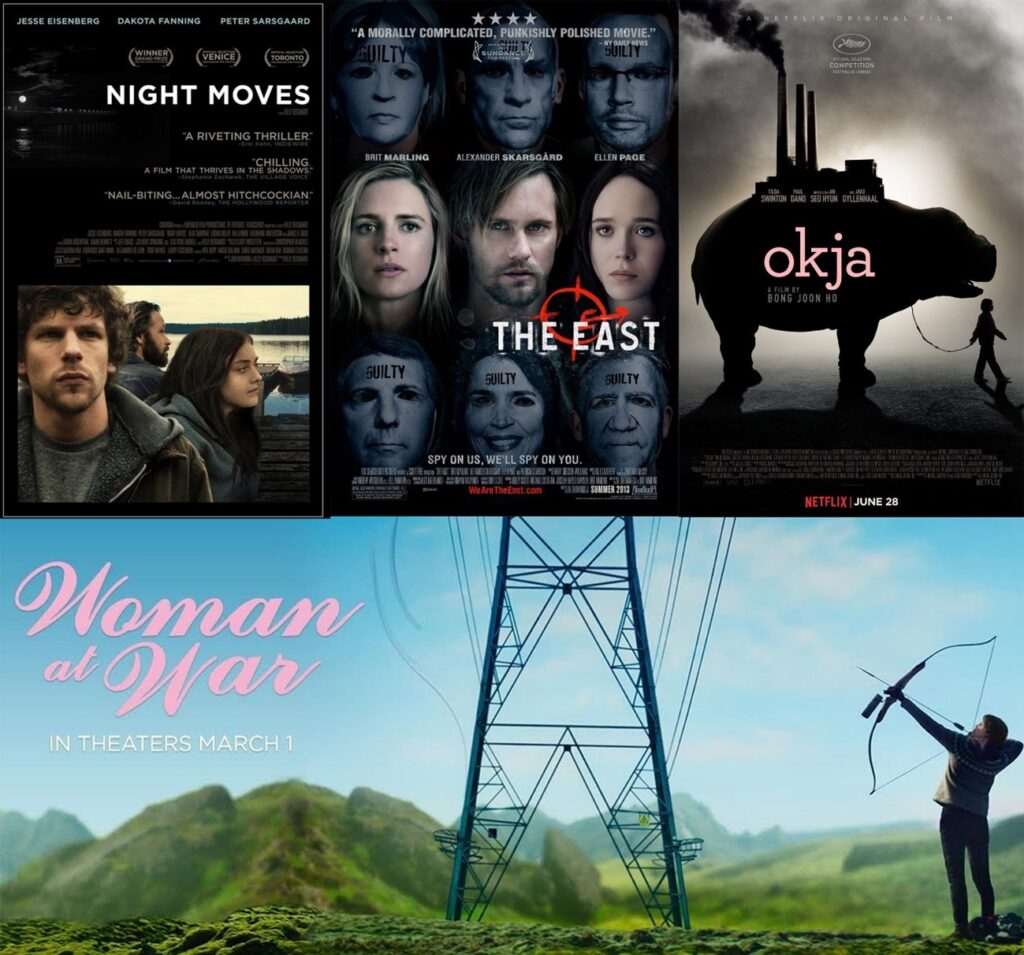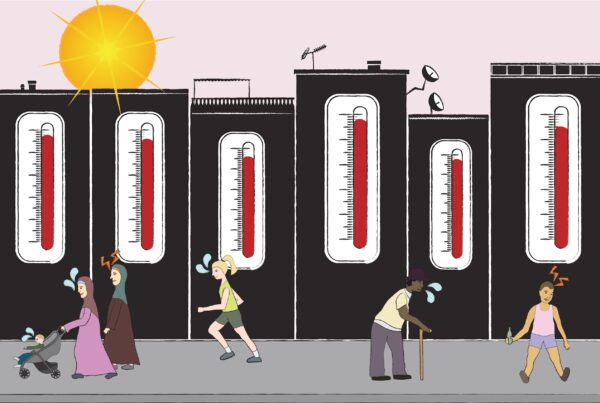by Xander Dunlap
How do political films depict, reflect and imagine struggle? What do they dramatize and what do they hide? Xander Dunlap examines recent political cinema through the perspective of political ecology
Film is a powerful medium. The assemblage of cinema produces vision-machines, which depict but also project futures, dilemmas and struggles. The machine production of visions is the process by which the trials and tribulations of life are transformed into a commodity to consume for the many. At the same time, films can impart empathy with characters, provide lessons, influence imaginations, promote ideologies, stereotypes and fears. Said simply, film is a dangerous weapon, or at least it could be, and often is a double edge sword deserving greater discussion.
Considering political ecology’s, and other academic disciplines’, claim that research is not merely for understanding the world, but for changing it for the better (and what constitutes ‘better’ is not always clear),[i] let us contextualize and consider how the recent waves of political films depict, reflect and imagine political struggle.
Academia, and younger generations, have consistently shown themselves ignorant of and, at best, flirtatious with the struggles, politics and political lessons from earlier generations. Movies can at least begin to turn the attention to past lessons but also serve ideologically driven and pacifying (statist/liberal) agendas. Providing a brief, and incomplete, genealogy of political ecology and revolutionary films, this piece seeks to highlight the political lessons misdirected by film and erased by the media-security industrial complex.

Paul Virilio’s (1989 [1984]) War and Cinema. Source: Verso Books
Political Ecology & Film
The collision, intersection and reification of political and ecological entanglements in film can take the form of numerous genres. While The Battle of Algiers (1966) and Costa-Gravis’s Z (1969) are foundational to the genre of political drama, we might recognize the consistent flow and recent upsurge in political ecology cinema—films depicting struggles over land.
While recently How to Blow up a Pipeline (2022) grabbed headlines, like Malm’s book (and the climate justice movement), it ignores (and implicitly attempts to discredit) past eco-anarchist and Indigenous struggles, even when acknowledging them. The genre of eco-anarchist, earth and animal liberation struggles and films, as they overlap, have been as entertaining as slanderous, with some useful considerations and legitimate movement critiques emerging.

The Battle of Algiers and Z. Source: IMDb
From Night Moves (2013) to The East (2013), we witness eco-anarchist/liberation struggles largely slandered. While Michael Truscellos commentary on Night Moves is generous and astute, the film is designed to promote paranoia while The East exaggerates cult attributes and ‘group think’ of networked eco-anarchist cells.
While The East is a bit more generous and accurate, these films fictionalize and tamper with Earth Liberation Front (ELF) struggles and the history of the ‘Green Scare.’ Night Moves is loosely inspired by the Eric McDavid case and The East by the ELF more generally.
Transcendence (2014) is backdoor pro-transhumanist film that depicts ecological extremist groups reminiscent of the Individuals Tending towards the Wild/Savage Reaction. The film positively raises questions concerning the potential of artificial intelligence/singularity. Pipeline (2022), is more affirming of struggle and emerges from this genre, adjusting the focus on rising climate concerns and on Indigenous identity following the No Dakota Access Pipeline struggle.
With the exception of Transcendence, in all three films with various levels of inaccuracy, militant actions and the in-fighting of saboteurs and bombers is depicted as haphazard and cringe at best. The efforts of saboteurs are depicted as fraught, laborious, personally treacherous and, in the end, not worth the effort.
Korean director, Bong Joon Ho’s Okja (2017) demonstrates an important political critique of the Animal Liberation Front’s (ALF) moralism and juxtaposes it against the friendship and connection of the main character, Mija, with their friend, Okja.
The Icelandic film, A Woman at War (2018), seems the most realistic in terms of a ‘lone wolf’ campaign against an aluminum smelter and navigating life and political struggle, which comes highly recommended. While this list of films is not exhaustive, let’s consider some stereotypical traps and pitfalls in political ecology film and beyond.
Political Struggle & Cinematic Traps
A general trend emerges around political cinema that viewers should consider carefully. In particular, these six mutually reinforcing and overlapping techniques. First, film depicting the police/military/authority perspective often attempts to humanize and share their side of the story, ignoring the organized machine of political violence, pollution and torture expressed by structural, symbolic and slow violence.
The state apparatus and liberal democracy quickly become unquestioned and celebrated. Seeing like the state, often through views of security cameras, police and spy’s, secondly, gives the psychological impression that they are all powerful—knowing, seeing and watching—enacting the principle of the panopticon through film (i.e. psychological warfare).
Closely related, and thirdly, these films provoke paranoia. Authorities are displayed to have a lot of resources, surveillance technologies, infiltrators and they are everywhere, which is designed to create (overwhelming) paranoia. While political struggle is treacherous and complicated, and authorities have been progressively accumulating power, paranoia is wielded as a weapon to disable and neutralize people from the inside-out. Fixation on “the government is everywhere” or “9/11 is an inside job” is irrelevant to political struggle and ignores the well-known conspiracies in plain sight.
Fourthly, films assist in integrating certain political conduct, operations and technologies into everyday life. Technology as Symptom and Dream by Robert Romanyshyn is excellent in showing the way dreams and vision manifest technologies into the present. The same is true with film: by seeing you believe it and can imagine it. Next thing you know you have robot dogs working for police and driverless cars surrounding you in traffic in California cities. By normalizing technologies and governmental activities before they happen, it seeks to integrate a particular reality and, consequently, attempts to mitigate revolt.
Fifth, the resistance, in the end, is depicted as stupid, riddled with in-fighting or betrays itself. The implicit message: Why risk your life in political struggle when people are hopeless, incompetent and ready to betray you for safety from the enemy and the highest bidder?
This relates to the sixth point, which was particularly noticeable throughout the fiction Andor (2022, 2024) and at the end of the historical adaptation Say Nothing (2024) series: Why did they fight in the first place if nothing changes and people sell out? What did all the IRA murders accomplish (while forgetting about British colonial occupation and massacre)? These questions should cause serious political, strategic and tactical reflections.
There is, however, a reoccurring high-level of self-importance from people attempting to ‘be political,’ which believe large-scale changes happen from attending a demonstration or organizing political actions. Political struggle is a long-term and ardent process. It should not be approached simplistically, which is what mainstream films and series seek to portray.
Conclusion
Film is frequently employed to advance a political agenda. Even explicitly revolutionary or radical films often have defeatist narratives or secondary pacifist messages designed into them. This article seeks to encourage media literacy, but also academic awareness of how films portray struggles and the type of messages that condition our politics and actions.
Political intelligence, however, comes with committed interest and experience, when too often academia encourages people to live vicariously, and judgmentally, through other peoples’ lives and their struggles (often in the Global South). Too often, people forget their conflicts and instead recede into the easiest and most familiar narratives organized by the media and film industries. No matter their failures in reality, and how films mask liberatory politics, films could still raise important questions and critical political reflection, even with all the manipulation they entail. That is, if the viewer is always critically attentive.
—
[i]This statement is attributed to Marx, but political ecology and geography has done poorly on the whole to recognize how much Marx drew from Proudhon, and that Bakunin predicted Leninism and Stalinism emerging from Marx’s work.





